
Types of Fry Pans
Shop All Frying Pans
A frying pan, or skillet, has a round shape, sloped sidewalls, and a lightweight design, which are helpful features when tossing foods in the pan. Its rim is wider than the cooking surface to promote the quick evaporation of liquids.
Saute vs Frying Pan
Saute pans have higher sidewalls than frying pans, which makes them better suited for cooking foods in more liquids without the risk of the liquids spilling over. A frying pan is ideal for shallow frying meats and vegetables with very little liquid. Despite its name, many chefs prefer sauteing foods in a frying pan over a saute pan because its sloped sides make it easier to toss foods.
Use of Frying Pan
A frying pan is ideal for cooking foods using high-heat cooking methods like frying, scrambling, sauteing, searing, and browning with little to moderate amounts of fat.
Frying pans come in a variety of materials. Which type of frying pan is best for you will depend on what you are cooking and the level of maintenance you want to put into your pan. In most cases, you will likely need a few different types of frying pans to satisfy cooking your menu items. Take a look at these five frying pan types to determine which pans you need in your kitchen.
1. Cast Iron Skillets

While cast iron skillets take longer to heat up than other frying pan materials, they heat evenly and consistently with no hot spots. They are great at retaining heat and can be taken from the stovetop to the oven or grill and then to the table for service to keep the food warm. A well-seasoned cast-iron skillet is naturally non-stick and can withstand very high temperatures without warping or getting damaged. Cast iron requires frequent maintenance, but the benefit is that it can last a lifetime with routine seasoning and using proper cleaning techniques.
Can You Put a Cast Iron Skillet in the Oven?
Yes, a cast iron skillet can be taken directly from the stovetop to the oven and vice versa. It can withstand high heat for an extended time and retain that heat for long periods, making it great for use as a serving vessel.
Can You Put a Cast Iron Skillet in the Dishwasher?
No, your should always clean your cast iron skillets by hand. A dishwasher will strip a cast iron skillet of its seasoning and cause it to rust.
Can You Use Metal Utensils on Cast Iron Skillets?
Yes. Cast iron is extremely durable and when properly seasoned can stand up to metal utensils without its surface getting damaged. Metal utensils are a great option to use with cast iron to ensure your utensils can withstand a cast iron's heat retention.
How to Clean a Cast Iron Skillet
Once the pan has cooled down, use a clean paper or lint-free towel to wipe excess oil and grease. Cover the skillet's surface with coarse kosher salt, add a small amount of hot water to form a paste, and scrub with a sponge to remove any stuck-on food. Rinse the pan with hot water and then thoroughly towel dry the skillet. Evenly rub a light layer of cooking oil onto the inside of the skillet and store it in a dry place.
2. Aluminum Frying Pans
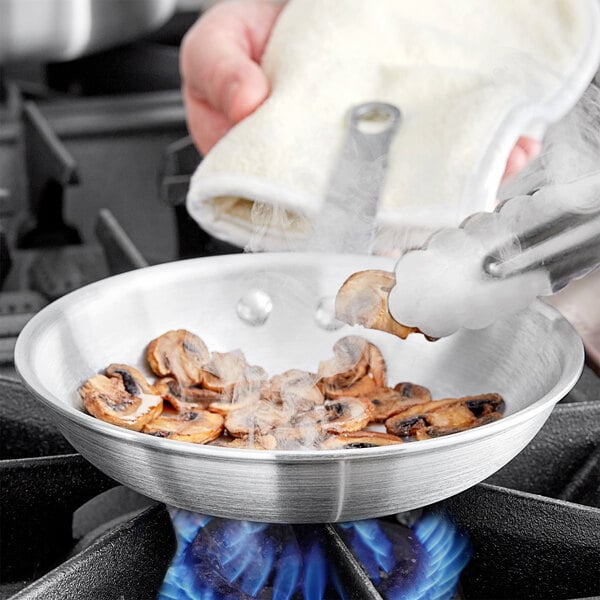
Offering excellent heat conduction, aluminum frying pans dissipate heat quickly for efficient, even cooking. Uncoated aluminum frying pans have a stick-, rust-, and corrosion-resistant surface and should only be used to cook low-acidic foods since acidic foods, such as tomato paste, citrus, and vinegar, react with aluminum and can alter the flavor of your food. Many professional aluminum frying pans are hard-anodized or feature a non-stick coating to make them non-reactive. Aluminum pans are not compatible with induction cooktops since aluminum is not magnetic.
Can You Put Aluminum Pans in the Oven?
As long as it is labeled oven-safe, aluminum pans are safe to use in the oven. Aluminum has a high melting point of 1,221 degrees Fahrenheit so it can handle high cooking and baking temperatures.
Are Aluminum Pans Dishwasher Safe?
No, aluminum pans should be hand-washed only. Aluminum cannot withstand the high heat of the dishwasher or harsh dishwashing chemicals, which can tarnish or stain the surface.
Can You Use Metal Utensils on Aluminum Pans?
You cannot use metal utensils on aluminum pans. Since aluminum is a soft metal, using metal utensils on an uncoated aluminum surface can damage its surface. You can use metal utensils, except for sharp kitchen knives, on hard-anodized aluminum pans. The anodization process adds a thick layer to the aluminum, which increases its durability and scratch resistance.
How to Clean Aluminum Pans
Once the pan has cooled, hand-wash the pan in warm water with mild dish detergent and a sponge. Use the rough side of the sponge or wooden spatula to scrape off stuck-on food bits. Never use steel wool or other abrasive scrubbers to clean the pan, as this can scratch the metal.
3. Non-Stick Frying Pans
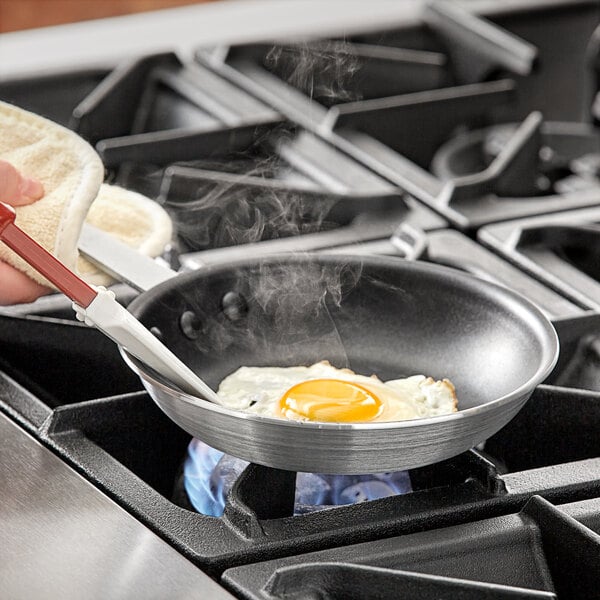
Typically made by adding a non-stick coating to aluminum pans, non-stick frying pans are ideal for cooking delicate foods with a tendency to stick, such as fish, fried eggs, and pancakes. The non-stick coating limits the amount of oils and fats needed to cook food and makes cleanup a breeze since your food won't stick to the pan. Non-stick pans are best used in low to medium heat settings to extend the coating's life. Using a non-stick pan in high-heat applications can damage the coating and cause it to smoke, peel, or flake.
Can a Non-Stick Pan Go in the Oven?
It depends. Not every non-stick pan is oven-safe, so you should confirm with your pan's manufacturer. Some non-stick pans are oven-safe up to 500 degrees Fahrenheit.
Can You Put Non-Stick Pans in the Dishwasher?
No, you should hand-wash all non-stick cookware to ensure its longevity. Strong dishwashing detergents and the high heat from the dishwasher will damage the non-stick coating over time.
Can You Use Metal Utensils on Non-Stick Pans?
You cannot use metal utensils on non-stick pans as this will chip and scratch the chemical non-stick coating that can then flake into your food. If they become chipped or scratched, they will need to be discarded immediately and replaced. Instead of metal utensils, opt for wooden or silicone utensils when using a non-stick pan.
How to Clean Non-Stick Pans
Thanks to their coating, non-stick pans are easy to clean. Once the pan has cooled down, use a clean paper or lint-free towel to wipe excess oil and grease. Hand-wash the pan in warm water with mild dish detergent and a sponge. Never use steel wool or other abrasive scrubbers to clean the pan, as this can scratch the coating.
4. Stainless Steel Frying Pans

For durable, long-lasting pans that are easy to clean and usable on induction cooktops, stainless steel frying pans offer a great solution. Their non-reactive properties make them an excellent pan for slow-simmering tomato sauces and other acidic recipes. Stainless steel does not conduct heat well, so most commercial stainless steel pans will have an aluminum-clad bottom to promote even heat distribution and eliminate hot spots. The main drawback of stainless steel pans is that they aren't naturally non-stick, but this can be combated with proper preheating and cooking oils.
Can You Put Stainless Steel Pans in the Oven?
Most stainless steel pans are oven-safe. However, the max oven-safe temperature may vary by manufacturer and product line, so it is necessary to check your item's specification sheet before use.
Are Stainless Steel Pans Dishwasher Safe?
It depends. Some manufacturers will label their pans dishwasher-safe, but for the longevity of your pans, it is best to hand-wash stainless steel pans. Dishwasher detergents can be harsh on the stainless steel and may lead to corrosion, and in general, regularly dishwashing your pans will dull and spot them over time.
Can You Use Metal Utensils on Stainless Steel Pans?
Yes. It is safe to use metal, wood, and high-heat silicone utensils on stainless steel pans.
How to Clean Stainless Steel Pans
Once the pan has cooled, handwash the pan in warm water with mild dish detergent and a sponge. For stuck-on foods, use the rough side of the sponge or wooden spatula to scrape off food bits. Never use steel wool or other abrasive scrubbers to clean stainless steel pans as this can scratch the metal. If your stainless steel pans are labeled as dishwasher-safe, make sure to use a metal-safe detergent to protect the pans' surface.
5. Carbon Steel Frying Pans
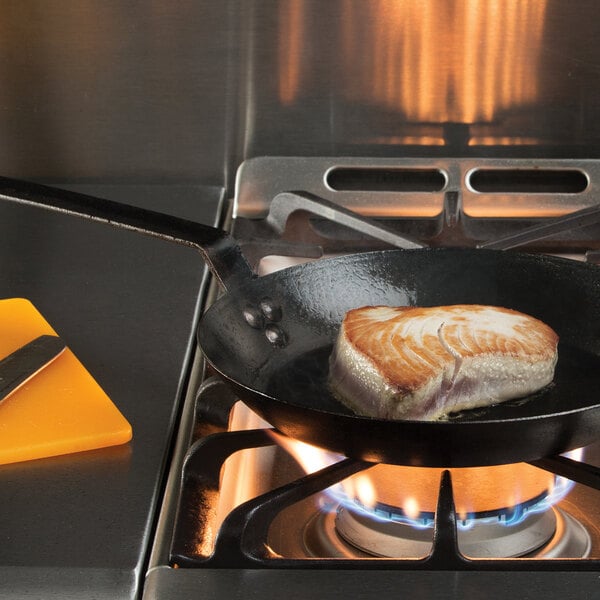
Like their aluminum counterpart, carbon steel frying pans are an excellent conductor of heat. However, they are a more durable and long-lasting option with the proper care, plus they can be used on induction cooktops. They can maintain both low and high temperatures for greater versatility and can cook both delicate foods like eggs and fish as well as sear thick meats like steaks and pork chops. Like cast iron, carbon steel pans require regular seasoning to maintain their non-stick capabilities. However, they heat up faster and are more lightweight, making them a great alternative to cast iron skillets. It is important to note that carbon steel pans are not ideal for cooking acidic foods as they can alter the foods' taste.
Can a Carbon Steel Pan Go in the Oven?
Yes. Like cast iron, a carbon steel pan can handle very high heat and go from the stovetop or grill to the oven without damaging the pan.
Can You Put Carbon Steel Pans in the Dishwasher?
No, carbon steel pans are not dishwasher safe, as they can rust in moist environments. Instead, carbon steel frying pans should be hand-washed with warm water and a soft-bristle brush or non-scouring sponge.
Can You Use Metal Utensils on Carbon Steel Pans?
Yes. Carbon steel pans are extremely durable, and once the pans are well-seasoned, they can stand up to metal utensils without getting scratched.
How to Clean a Carbon Steel Pan
Use a clean paper or lint-free towel to wipe out any excess oil and grease. Wash the pan with warm water and a soft-bristle brush or a non-scouring sponge. For stuck-on food, fill the pan with just enough water to cover the bottom and let it simmer for 3 to 5 minutes. Allow the pan to cool and then scrape the food off with a spatula. Immediately dry the pan with a paper or lint-free towel and then evenly rub a light layer of cooking oil onto the pan.

Properly cleaning your frying pan can make all the difference in its longevity. While some manufacturers may label their pans as dishwasher-safe, it is always best to hand-wash your pans to avoid potential damage caused by harsh dishwashing chemicals or a dishwasher's high heat.
A non-stick pan has an easy-release coating that prevents foods from sticking to the pan. They are ideal for delicate foods that cook over low to medium heat, such as eggs, pancakes, crepes, seafood like scallops and tender fish, cheesy dishes like quesadillas or grilled cheese, and nuts.
Since there is no coating to worry about damaging, untreated stainless steel pans are a more durable option than non-stick pans. However, they are not naturally non-stick, so burnt-on food can be a pain to remove; therefore, they may not be the best option for cooking delicate foods. Stainless steel pans tolerate much higher temperatures and are great for browning and searing foods like meats and vegetables.
Types of Non-Stick Coating
There are a variety of non-stick coatings a frying pan can have, such as a standard PTFE non-stick coating to manufacturer-specific coatings. Read on to learn more about the different types of non-stick coatings a pan can have, ranging from good to best.
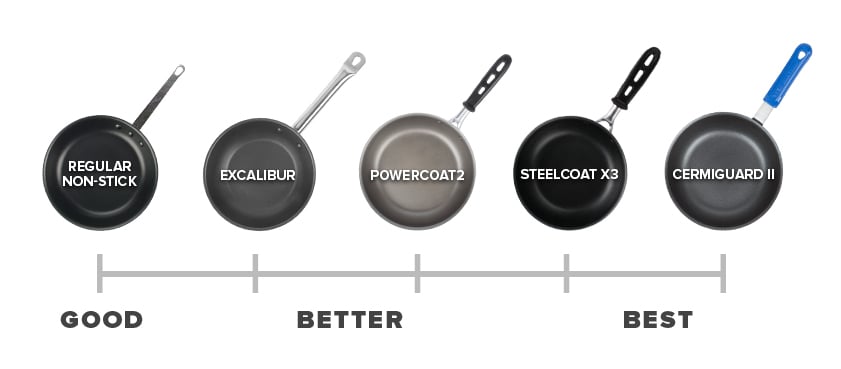
- PTFE Non-Stick Coating: This is a standard non-stick coating that is affordable, easy to clean, and reduces the need for oil and cooking fat.
- Excalibur Non-Stick Coating: This coating is reinforced with a stainless-steel alloy for longevity and is more durable than the standard non-stick coating. It is PFOAs-free and scratch-resistant.
- PowerCoat2 Non-Stick Coating: Proprietary to Vollrath, this dual-layer, ceramic-reinforced coating is PFOAs-free and environmentally friendly.
- SteelCoat x3 Non-Stick Coating: Proprietary to Vollrath, this triple-layer ceramic coating provides superior food release and is PFOAs-free.
- CeramiGuard II Non-Stick Coating: This dual-layer, ceramic-reinforced coating offers the longest release life by Vollrath. It works well in high heat conditions, is abrasion-resistant, and is PFOAs-free.
Once you've decided which frying pan material you need, the next step is to figure out the pan size. Frying pans come in different sizes, with 8-, 10-, and 12-inch being the most popular sizes across the industry. The smaller the pan size is, the faster it heats up and evenly distributes the heat, but the faster it will lose its heat. While it may seem like a larger pan size is always better, some foods, such as eggs, benefit from cooking in a smaller, more contained space. We have listed the most common commercial frying pan sizes below and what they are best for:
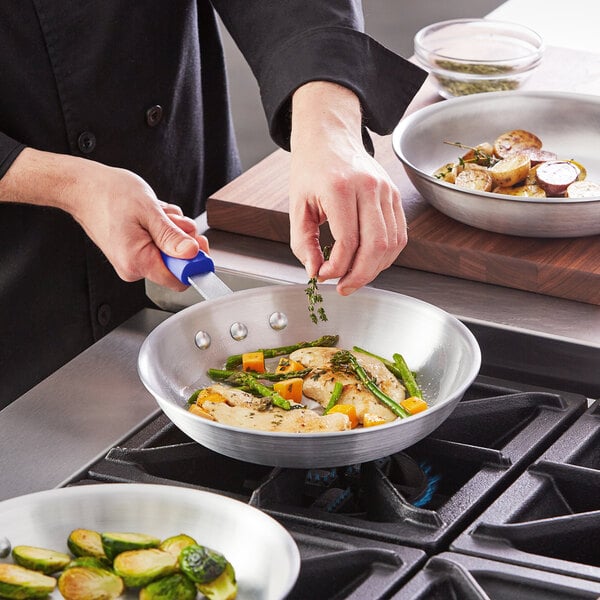
- 7" Pan: A 7" pan will heat up very quickly and is ideal for making single servings of eggs and other small portions.
- 8" Pan: An 8" frying pan is the best size for making a classic three-egg omelet. It is also ideal for making single-servings of crepes, sauteing vegetables for a side, and searing small steaks and fillets.
- 10" Pan: A 10" pan works well for cooking entrees and offers the perfect balance of a large cooking surface while still heating up relatively fast.
- 12" Pan: A 12" pan is ideal for cooking entrees and foods that need a larger space than a 10" pan can provide. Cooking methods like browning and pan-frying require more cooking space to ensure moisture evaporates and the food's crust crisps to perfection.
- 14" Pan: A 14" pan is ideal when cooking for large groups and prepping large quantities of food at once.
How to Measure a Fry Pan
To determine a frying pan's size, measure the pan's diameter from rim to rim. A frying pan's advertised size is not the diameter of the cooking surface, and due to the tapered design of a frying pan, that diameter will always be around 2" smaller.
Frying Pan Thickness
A frying pan's thickness is measured in either gauge or mils. -1 mil is equal to 1/1000", so the higher the mil, the thicker the metal. The gauge works oppositely - the higher the gauge, the thinner the metal. A thick pan is more durable than a thin pan but may not conduct heat as quickly. Most commercial frying pans will fall between a thick 10-gauge construction and a thinner 22-gauge construction.
Related Resources
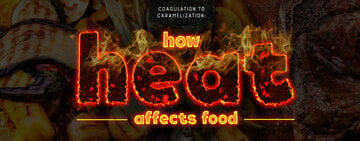
Coagulation to Caramelization: How Heat Affects Food
We all know that most food preparation involves heating the food , whether by roasting, baking, grilling, frying, or searing. We know that during the cooking process, red meat gets brown, liquids become solid, and flavors change. But have you ever wondered why that is? In order to help you better understand the cooking process, we've explained the basics of why food reacts the way it does when it's heated up. Proteins: Coagulation Plant- and animal-based foods are made up of long molocules called proteins. When they're heated, the proteins break up and lose moisture. This makes them change from a liquid (or semi-liquid) to a solid in a process called coagulation in food. Temperature this starts at: 140 degrees F Examples: hard boiled or fri
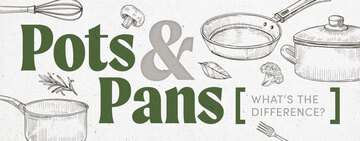
Pots vs Pans
Matching the proper cookware with the right cooking method is tricky when there are so many types of pots and pans to choose from. Each type of cookware has unique benefits that can improve your dishes when used correctly. We'll explain the differences between pots and pans and identify 5 of the most popular styles so you can choose the right pan for the job. Shop All Cookware What Is the Difference Between a Pot and a Pan? A pot has tall sides and two loop handles, while a pan is shallow with one long handle. Pots are used for simmering or boiling liquids that completely cover ingredients to cook from all sides. Pans are used for cooking methods that apply high heat to produce browning , like reducing, sauteing, searing, or frying. We'll i
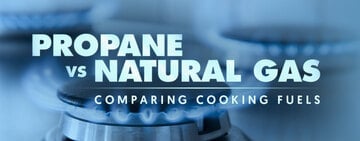
Propane vs. Natural Gas: Comparing Cooking Fuels
Whether you manage a restaurant , cafe, or food truck , gas-powered cooking equipment is frequently used in foodservice operations. Gas burners generate significantly more heat than electric burners, allowing for faster cooking times and greater efficiency in the kitchen. The two main types of gas used in commercial settings are propane and natural gas. We'll introduce both types and what sets them apart below. Use these links to learn more about propane and natural gas: What Is Natural Gas? What Is Propane? Difference between Propane and Natural Gas What Is the Cost of Propane vs. Natural Gas? Propane and Natural Gas FAQ What Is Natural Gas? Natural gas is a fossil fuel extracted from the ground. It is primarily composed of methane, a colo
- Topics 1356
- Industrial 55
- Troubleshooting Guides 21
- Restaurant Management 128
- Bar Management 56
- Catering Tips 36
- Bakery Management 42
- Food Trucks & Concessions 49
- Advertising & Marketing 37
- Eco-Friendly Tips 11
- Facility Layout & Design 42
- Coffee Shop Tips 28
- Installation & Maintenance 51
- Janitorial & Pest Control 30
- Safety & Sanitation 88
- Startup Tips 104
- Menu Design 10
- Kitchen & Cooking Tips 83
- Hospitality Management 24
- Pizza & Sandwich Shop Tips 36
- Smallwares 37
- Food Prep 89
- Tabletop Items 17
- Disposables 22
- Calculators & Tools 6
- Consumables 52
- Warewashing & Laundry 19
- Cooking Equipment 91
- Food Storage & Refrigeration 51
- Beverage Equipment 35
- Office Supplies 6
- Resource Type
- In-Depth Articles272
- Buying Guides298
- How-Tos95
- Product Reviews78


